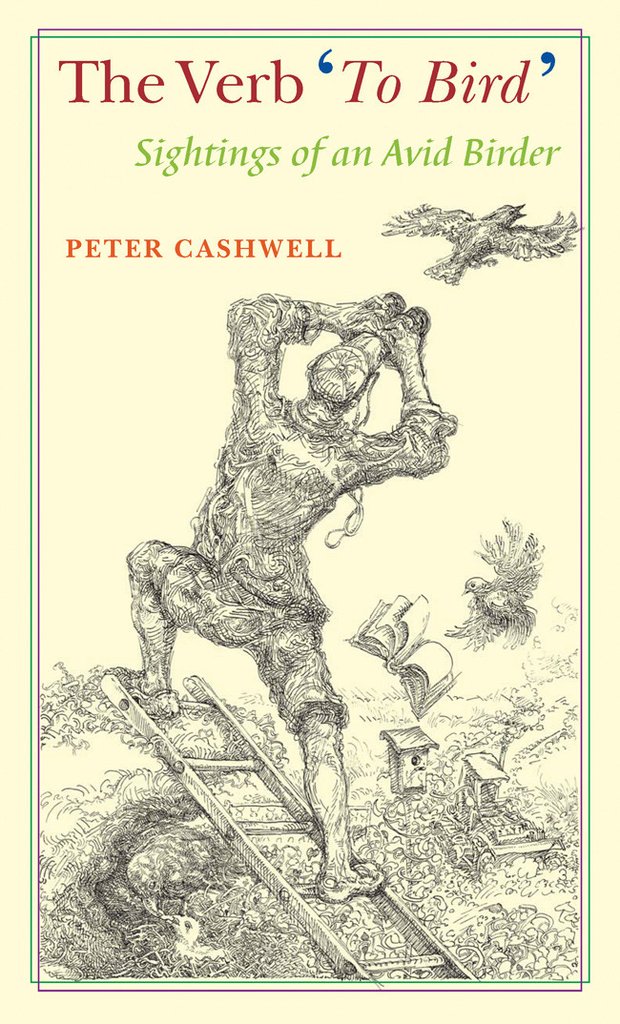By Anne Kilgannon

One of my favorite places to read during the warm months is our Adirondack chair that sits on the front porch of our house with a view of our garden trees, birdbath, and well-frequented hummingbird feeder. I need only look up to watch birds and wonder which ones are making a rustle in the bushes. Recent passers-by on the sidewalk not many feet away may well have wondered what kind of bird made all those chuckling and even occasional hooting sounds from my porch. No exotic wildlife; just me reading Peter Cashwell’s memoir of his bird watching adventures. He is in turn hilarious, thoughtful, inspiring, and did I say funny? How often have you laughed out loud reading a bird book?
Cashwell has worn many hats in his professional life, including radio announcer and DJ, rock musician, and at the time of writing, an English teacher; hence the grammar lesson in the title of the book. He begins with a bit of a lesson on “to bird” as an acceptable usage and goes on throughout the book to prove just how active a pursuit birding can be. He readily admits to a chronic case of Birding Compulsive Disorder, which leads to some near-misses while driving, comically erratic behavior and other faults, but he doesn’t wish to be cured of his malady:
If I were cured, I would no longer have any interest in the glossy backs of grackles, or the bounding flight of goldfinches, or the alert strut of the Killdeer. I’d give up walking in the woods before sunup and peering out at seed scattered on the snow for the Cardinals. Falcons would become a matter of indifference to me, or the sight of a heron beating his wings against the sunset wouldn’t even raise an eyebrow….Bring on the plague, I say.
He had me at goldfinches. Without birds life would surely lose all of its savor. And although poking abundant fun at himself, Cashwell is a serious birder. For the first time, I really understood the power of having a life list and actively pursuing birds not yet documented by date and place of personal experience. To want to see a bird for yourself you first have to know where and when to look, and what to look for: what field marks distinguish your bird from another. His Peterson guide must be dog-eared and splayed from constant use.
Cashwell admits there are other guides and that he has been known to consult them—in fact he knows his reference materials backwards and forwards—but he is a loyal Peterson adept. So familiar is he with its pages, he knows every eye stripe, tail shape, bend of wing and leg color of birds he hopes to see before heading outside but still checks and confirms in an honest accounting before listing any sightings. Peterson is succinct, but Cashwell is memorable and even poetic in his bird descriptions. Here he is describing what many think an unattractive bird, none too fascinating, but think again:
With a host of creaky, rusty, grating jeers, the foothills teem with Common Grackles. Their blackness mottles the telephone wires all the way from Orange to Culpeper, and the corners of my eyes are full of the smooth arc of their flight. Their tails are wedge-cut, longer in the center than at the edges, and when the birds fly, the center feathers drop down a bit, leaving a shallow V, as though they’d been folded—as if the birds had been made, in their thousands, through origami.
Birds shaped as by origami: an indelible image, one I’ll look for and remember. He goes on to say:
When the sun hits them, the Grackle’s feathers explode into bronzes, purples, greens, and indigos, and their yellow eyes wink, as if they know just how much beauty they’re sneaking past the unobservant. In North Carolina [where he once lived] I never noticed them, because they were always there; now, simply by removing themselves from my presence for five months, they’ve made me miss them. Every scrubby cedar has a branchful of Grackles on it, and I welcome the sight.
Cashwell, even after years—a lifetime—of birding, and an impressive life list to his credit, is still open to wonder, still marveling at the sight of birds, no matter how often seen, ordinary, every-day, but miracles of color and form and alive with being. He had momentarily worried that he might be jaded, might have seen all the birds he was likely to see, and yet it was Grackles that he had seen hundreds of times that awed him, once again: Maybe I can still be reached.
Maybe that’s the secret power of birds. They are everywhere but they can still startle, grab our attention, flash us with beauty, keep us looking, wakeful and hopeful. Cashwell knows this and with all his wit and wry observations that disarm and relax us as readers, he slips in these profound truths about why birding is a verb and why we should all be doing it, now and always.







